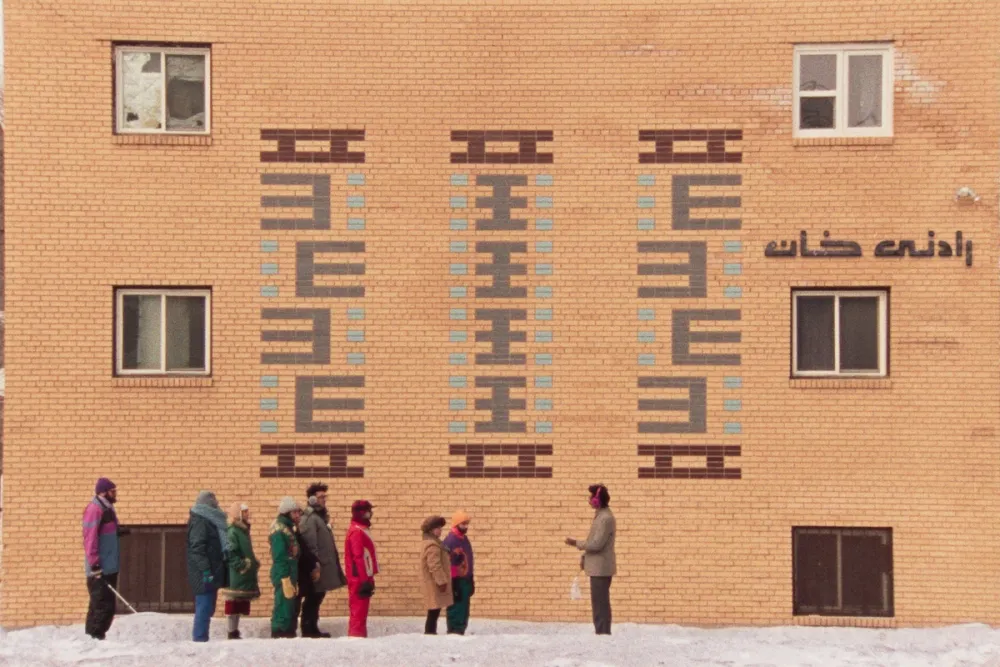Matthew Rankin’s Universal Language (2024) opens with a gag, one of many in a film filled to the brim with them, though this one bears the burden of unmistakable historical significance. In the first frame on screen text cheekily declares that the film was produced for the “Winnipeg Institute for the Intellectual Development of Children and Young People”. Such an institute, of course, does not exist, instead being a direct reference to Iran’s own “Institute for Intellectual Development of Children and Young Adults”, which was famed for producing the first films of Abbas Kiarostami, the most renowned Iranian filmmaker of all time. Rankin does not shy away from announcing the influence of Kiarostami and the Iranian New Wave as a whole on his work, directly lifting the Universal Language’s plot structure and visual palette from the films of that era. The film initially follows two siblings Nazgol and Hussein who find a banknote frozen in ice and attempt to retrieve it in order to buy new glasses for a classmate whose glasses have been stolen by a rogue turkey. Comparisons immediately abound to Kiarostami’s own Where is the Friend’s House? (1987), which similarly follows a schoolboy’s attempt to return his friend’s notebook, while akin to Jafar Panahi’s The White Balloon (1995) adults are periodically roped in who find the selfless ordeal these children subject themselves to wholly naive. The film’s visual language likewise borrows from both filmmakers, being composed of various flat, geometric still shots of a town which the characters repetitively traverse through, foregrounding the act of walking as a way of literally tracing the geography and history of the landscapes. But within all of this an important distinction is stressed throughout Rankin’s film: this is Winnipeg, Canada, not Iran.
The filmmakers of the Iranian New Wave carried with them an obsession with examining cinema’s relationship with realism, stretching the medium to its limits, causing the audience to consider the fine line between intention and spontaneity, reality and artifice. Though Rankin’s film decidedly defies the core tenets of his influences by fully embracing artifice. Universal Language takes place in Winnipeg though judging by every signifier it actually takes place in Iran: as everyone appears to be of Iranian descent, everyone speaks in Farsi and everyone drinks shirin chai. Rankin’s Winnipeg is a wondrous world caught between two cultures, and through the film’s immaculately detailed and carefully manicured production design he creates various cinematic delights ranging from an Iranian Tim Hortons to a medically sterile Kleenex factory. A clear point of comparison to what Rankin is doing is the recent work of Wes Anderson, who performed a similar cinematic gambit with films like Isle of Dogs (2018), which adopted the influence of filmmakers like Yasujirō Ozu and Akira Kurosawa but emptied them out of context until just their aesthetics remained. Though this would be to downplay what Rankin is actually attempting which is far more straightforwardly emotionally potent than Anderson’s usual fare
About a quarter of the way through the film we are introduced to the character of Matthew Rankin, played by Rankin himself, a man of mixed race descent who moves back to his hometown of Winnipeg to reconcile with his estranged Iranian mother. It is through this development that everything Rankin is doing cleanly clicks into place: using the crutch of cinema to remake his hometown in the image of a diaspora. As a Canadian native Rankin understandably cannot imagine the Iran his mother grew up in, nor the Iran that existed throughout his own childhood. Images from Iranian cinema of the 80s and 90s, as such fill in this gulf of cultural experience, attempting to recreate a world lost through immigration. If the Iranian New Wave sought to find artifice in truth, Ranking attempts to find truth in artifice, using this playful world to expose the limits of his cultural imagination, because his Iranian Winnipeg can never quite authentically capture either part of the equation. It is in this deficiency that the film’s emotional resonance builds as more and more it appears that Rankin’s elaborate cinematic creation is nothing except an attempt to reconcile both parts of his cultural identity and to reconnect with his mother by creating a world in a manner that she might have seen it, even if she struggles to see him herself. Amidst all the artifice real heartbreak cuts through. Once you leave home you can never quite go back the same way, nor can you recognize your loved ones quite as sharply, but through cinema you can grasp to find a shape, a smell or a memory, real or imagined.

